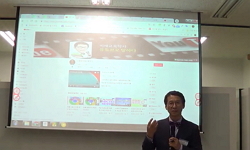Our current education system is gradually changing in order to follow advanced IT technology of future. However this system not just brings the benefits, but also causes the negative effects at the same time. Generally, online education is one-way tea...
http://chineseinput.net/에서 pinyin(병음)방식으로 중국어를 변환할 수 있습니다.
변환된 중국어를 복사하여 사용하시면 됩니다.
- 中文 을 입력하시려면 zhongwen을 입력하시고 space를누르시면됩니다.
- 北京 을 입력하시려면 beijing을 입력하시고 space를 누르시면 됩니다.

미래 디자인 산업 변화에 따른 디자인 교육 프로그램의 개선방향 연구 = A Study On The Improvement Of Future Design Education Program Along With Changes In Society
한글로보기https://www.riss.kr/link?id=A103647424
- 저자
- 발행기관
- 학술지명
- 권호사항
-
발행연도
2016
-
작성언어
Korean
- 주제어
-
등재정보
KCI등재
-
자료형태
학술저널
- 발행기관 URL
-
수록면
241-254(14쪽)
-
KCI 피인용횟수
2
- 제공처
-
0
상세조회 -
0
다운로드
부가정보
다국어 초록 (Multilingual Abstract)
Our current education system is gradually changing in order to follow advanced IT technology of future. However this system not just brings the benefits, but also causes the negative effects at the same time. Generally, online education is one-way teaching, and sometimes lacks in two-ways communication between students and instructors. For a designer, it is necessary to have the ability to communicate and share ideas with other people. Therefore, the current education should compensate the defect, one-way teaching, and will have to blend in the advantages of the current design education. Fusion education required in the future society is already being practiced in design education of developed countries. Fusion education supplies promising designers with chances to learn communication skill as well as to develop creativity and competitiveness. In this paper, we study can improve the program for the training of future talent in response to changes in future design industry. First of all, researched about the educational needs of design and compared the educational program of Korea and other countries. Unlike Korea, found out other developed countries not only exercise early-childhood education and various curriculum that are reflected in the educational goal but also encourage voluntary participation of the students. Furthermore, Noticed from other surveys about the design education that the students do not have interests in design itself nor the subjects that are related to design, and they even have problems with rap sessions. However, once the students take on interest, they gain confidence, and the participation rate and the satisfaction rate would increase. From this evidence, I could get to the conclusion that we need to improve our situation with collaboration between design and other subjects and comprehensive extension of the topics in order to arouse their interests and motivation. This will bring more active participation of the students.
국문 초록 (Abstract)
미래 사회에는 지금보다 훨씬 더 뛰어난 IT 기술의 발달로 인해 점차 추세에 맞춰나가는 교육방식으로 변모하고 있다. 디자인 교육에 있어서 일방적인 교육 형태가 더 많아졌다는 것은 쌍방...
미래 사회에는 지금보다 훨씬 더 뛰어난 IT 기술의 발달로 인해 점차 추세에 맞춰나가는 교육방식으로 변모하고 있다. 디자인 교육에 있어서 일방적인 교육 형태가 더 많아졌다는 것은 쌍방향 소통이 잘 이루어지지 않는다는 것을 말한다. 디자이너라는 직업은 사람들과 의견을 조율하고 소통하는 능력을 중요시하므로 미래 사회의 변모에 맞춰 교육방식이 현재의 디자인 교육에 자연스럽게 섞여야 할 것이다. 또한 미래 사회에 중요시되는 것 중 하나가 융복합 교육인데, 이것은 선진국의 디자인 교육에서 이미 실행되고 있으며 융복합 교육은 디자이너가 될 인재들에게 창의성을 길러주고 경쟁력을 길러줌과 동시에 소통의 중요성을 가르치는데 가장 큰 요인이 된다. 따라서 이러한 미래 디자인 산업의 변화에 맞추어 미래의 인재를 양성하기 위한 프로그램 개선방향을 연구하고자 한다. 우선, 디자인 교육의 필요성과 국내외 디자인 교육 프로그램에 대해 조사 및 비교 하였다. 선진국들의 디자인 교육 목표의식에 따른 다양한 커리큘럼과 조기교육의 실행, 그리고 학습자들의 자발적인 참여 유도가 국내 디자인 교육과 가장 큰 차이점 이었다. 또한 디자인 교육에 관련된 선행연구들의 학습자 설문조사 결과에서 프로그램 진행 시 학습자들이 디자인이나 디자인과 접목 된 타 과목에 대해 관심이 없거나, 그룹별 토론을 어려워한다는 점을 발견 했다. 그러나 수업에 흥미가 생기면 만족도와 참여도가 높아지고 자신감이 생겼다는 점을 주목하여, 학습자가 디자인과 교육에 적극적으로 참여하도록하기 위해서는 프로그램에 대한 흥미를 유발, 성취하고자 하는 동기부여를 할 수 있도록 다양한 교과목과 디자인의 접목, 포괄적으로 주제를 확장하는 방향으로 개선 시켜야 한다는 점을 확인하였다.
참고문헌 (Reference)
1 이선정, "콜라주를 활용한 광고디자인 수업에 대한 연구 : 중등 미술교육에서의 협동 학습을 중심으로" 인하대학교교육대학원 2016
2 양지성, "초등학교 어린이 창의력을 위한 디자인 교육 프로그램 개발에 관한 연구" 수원대학교 미술대학원 2010
3 박태호, "창의, 인성 교육을 위한 초등학교 디자인 프로그램 개발" 한국교원대학교 교육대학원 2016
4 고민정, "창원시 디자인 산업 경쟁력 강화를 위한 디자인 진흥 방안 연구" 창원대학교 2014
5 김윤미, "직업기초능력 향상을 위한 문학-디자인의 융합프로젝트 수업 지도안 개발" 충북대학교 교육 대학원 2016
6 이성애, "인지 발달적 상호작용에 기초한 유아 디자인교육 방법 연구 : 혼합연령 종일반 중심으로" 한양대학교 이노베이션대학원 2013
7 김혜원, "융합인재교육(STEAM)이 아동의 Flourish에 주는 함의" 숙명여자대학교 일반대학원 2015
8 채보라, "융합디자인교육을 통한 학교 미술교육 활성화 방안 연구" 숙명여자대학교 교육대학원 2014
9 최윤의, "유아 디자인교육 콘텐츠 개발 연구 : 통합교육적 접근" 홍익대학교 대학원 2014
10 권지은, "아동의 창의성 증진을 위한 문화적 기반의 디자인 조기 교육 프로그램 개발" 동서대학교 디자인전문대학원 2012
1 이선정, "콜라주를 활용한 광고디자인 수업에 대한 연구 : 중등 미술교육에서의 협동 학습을 중심으로" 인하대학교교육대학원 2016
2 양지성, "초등학교 어린이 창의력을 위한 디자인 교육 프로그램 개발에 관한 연구" 수원대학교 미술대학원 2010
3 박태호, "창의, 인성 교육을 위한 초등학교 디자인 프로그램 개발" 한국교원대학교 교육대학원 2016
4 고민정, "창원시 디자인 산업 경쟁력 강화를 위한 디자인 진흥 방안 연구" 창원대학교 2014
5 김윤미, "직업기초능력 향상을 위한 문학-디자인의 융합프로젝트 수업 지도안 개발" 충북대학교 교육 대학원 2016
6 이성애, "인지 발달적 상호작용에 기초한 유아 디자인교육 방법 연구 : 혼합연령 종일반 중심으로" 한양대학교 이노베이션대학원 2013
7 김혜원, "융합인재교육(STEAM)이 아동의 Flourish에 주는 함의" 숙명여자대학교 일반대학원 2015
8 채보라, "융합디자인교육을 통한 학교 미술교육 활성화 방안 연구" 숙명여자대학교 교육대학원 2014
9 최윤의, "유아 디자인교육 콘텐츠 개발 연구 : 통합교육적 접근" 홍익대학교 대학원 2014
10 권지은, "아동의 창의성 증진을 위한 문화적 기반의 디자인 조기 교육 프로그램 개발" 동서대학교 디자인전문대학원 2012
11 송병용, "미래 디자인 산업 변화에 따른 제품디자이너의 직무모형에 관한 연구" 홍익대학교 산업미술대학원 2013
12 신일주, "디자인적 사고를 기반으로 한 창의,융합 프로그램 운영 사례 분석" 한국교원대학교 교육대학원 2016
13 허강숙, "글로벌 환경 변화에 따른 디자인정책 발전방향 연구 : 디자인산업정책을 중심으로" 경희대학교 교육대학원 2008
14 고은빛, "감성적 표현을 위한 캘리그라피 (Calligraphy) 미술 수업 지도방안 연구 : 중학교 3학년을 중 심으로" 이화여자대학교 교육대학원 2016
15 윤지선, "STEAM(융합인재교육) 기반의 환경미술교육이 유아의 창의성 및 환경친화적 태도에 미치는 효과" 동국대학교 교육대학원 2015
동일학술지(권/호) 다른 논문
-
다감각서비스 시스템을 적용한 서비스디자인 사례연구 - 교육서비스의 정성적 평가를 중심으로 -
- 한국기초조형학회
- 박인찬
- 2016
- KCI등재
-
요셉 앨버스의 기초조형교육이 1960년대 작가들에게 미친 영향에 관한 연구 - 예일대학의 교육을 중심으로 -
- 한국기초조형학회
- 현정아
- 2016
- KCI등재
-
팝-쉬르레알리즘에서 나타나는 ‘그로테스크(Grotesque)’의 표현 연구
- 한국기초조형학회
- 오세권
- 2016
- KCI등재
-
- 한국기초조형학회
- 왕운비
- 2016
- KCI등재
분석정보
인용정보 인용지수 설명보기
학술지 이력
| 연월일 | 이력구분 | 이력상세 | 등재구분 |
|---|---|---|---|
| 2027 | 평가예정 | 재인증평가 신청대상 (재인증) | |
| 2021-01-01 | 평가 | 등재학술지 유지 (재인증) |  |
| 2018-01-01 | 평가 | 등재학술지 유지 (등재유지) |  |
| 2015-02-09 | 학술지명변경 | 외국어명 : Bulletin of Korean Society of Basic Design & Art -> Journal of Basic Design & Art |  |
| 2015-01-01 | 평가 | 등재학술지 유지 (등재유지) |  |
| 2011-01-01 | 평가 | 등재학술지 유지 (등재유지) |  |
| 2009-01-01 | 평가 | 등재학술지 유지 (등재유지) |  |
| 2006-01-01 | 평가 | 등재학술지 선정 (등재후보2차) |  |
| 2005-01-01 | 평가 | 등재후보 1차 PASS (등재후보1차) |  |
| 2003-01-01 | 평가 | 등재후보학술지 선정 (신규평가) |  |
학술지 인용정보
| 기준연도 | WOS-KCI 통합IF(2년) | KCIF(2년) | KCIF(3년) |
|---|---|---|---|
| 2016 | 0.33 | 0.33 | 0.34 |
| KCIF(4년) | KCIF(5년) | 중심성지수(3년) | 즉시성지수 |
| 0.34 | 0.34 | 0.512 | 0.08 |




 KCI
KCI DBpia
DBpia






